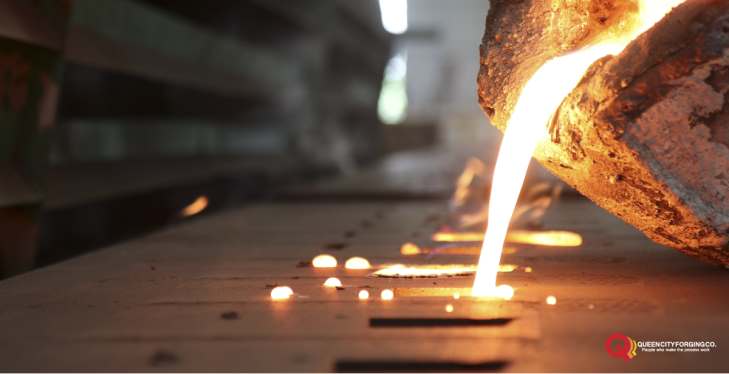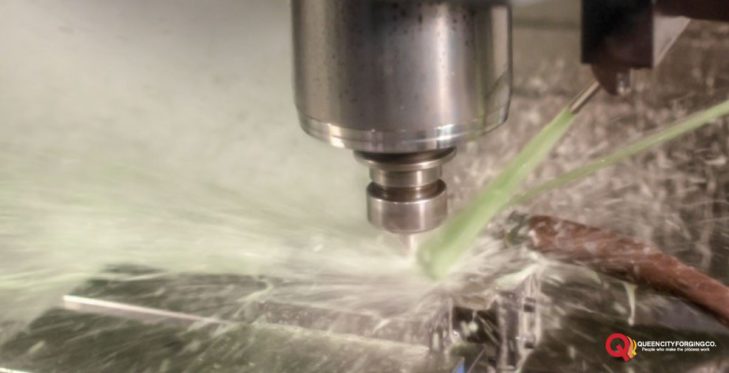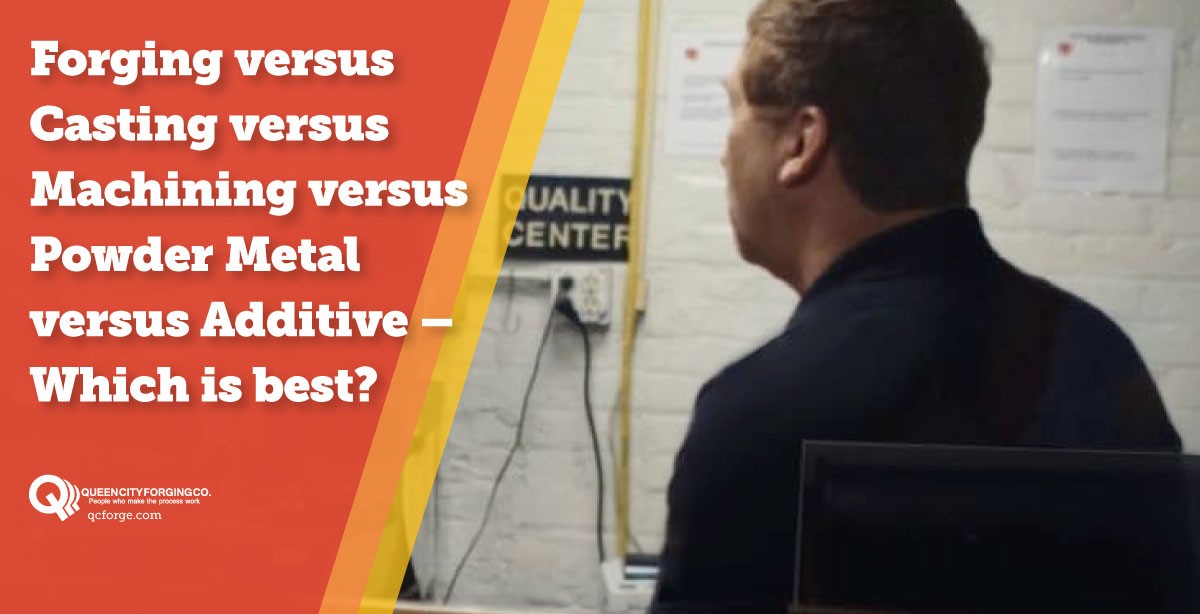Anyone engaged in process design for a metal product has a range of choices for the production of a component far beyond what design engineers had available just a few decades ago. This discussion is to focus on several of the typical metalworking processes, comparing the advantages and disadvantages of each. Many processes and possibilities, such as component parts made from polymers, fiber-reinforced epoxies, or items made entirely from ceramic material will not be addressed. Not all aspects of fabrication from metals and multi-element materials can be discussed here.
Not many generations ago, the choice for bulk metal materials forming was either forging or casting. The 18th and 19th Centuries, the era we call the “Industrial Revolution”, saw great advances in forging and casting technologies as well as the subtractive process we call machining. Casting can be considered the great-granddaddy of all the processes as it involved smelting, the process of obtaining the pure forms of metal from mined ores. Metals in liquid form, poured or forced into molds, are part of the basic casting process.
Forging adds the mechanical properties of pressing or hammering the metals to shape them while in a solid state. Forging alters the properties of the metals adding strength and durability to the configuration being produced. Machining removes “excess” material, cutting or eroding it away to reveal the desired configuration, much like a sculptor, chipping away everything not required to reveal the statue.
Metal powders were also being produced in the 19th Century but true volume application for component parts used in manufacturing gained acceptance during the 20th Century. Metal powders with added binders, compacted in presses, then strengthened with a subsequent thermal treatment, were some of the first uses of powdered metals. Today metals powders are also used in operations such as metal injection molding (MIM) and additive manufacturing processes that consolidate powder with lasers or frictional force.
All of these may be categorized as utilizing thermal and mechanical energy to produce configurations for end use applications. So, which is best for any specific use? The answer depends upon the service a component part must perform, the complexity of the design, and the cost to achieve the result.
Strengths and Weaknesses
Metal Powders
The uses of metal powders, often combined with other materials, allows an alloy selection that can be designed for a specific application. Powders can be blended to create materials that otherwise cannot be cast as it may enable a combination of elements that will not mix properly or may even react with one another in an attempt to melt and mix in a liquid form. Therefore, the ability to create combinations of elements to produce an alloy designed to meet the needs of an end product can be a distinct benefit of using powder as a raw material.
Another advantage is the ability of deliberately producing porous constructions – less than fully dense – where an article produced in this manner can serve a specialized function. An example is filter media, where the labyrinth of passages through a partially compressed metal powder blank act to block the flow of contaminants larger than the small gaps left in the finished insert.
Some disadvantages to the use of powder are the difficulty of achieving full densification and optimum or ultimate theoretical material properties when attempting to reconsolidate powder into the desired end configuration. Another concern, usually controlled with shop practice, is the potential for fine powder grains to become an airborne containment, presenting an environmental or health hazard. Traditional press compaction and some additive procedures require the addition of binders to hold the powder in the desired shape through sintering, the thermal process to burn off binders, and allow the remaining metal powder grains to bond to each other.
Similar issues exist with powder bed additive processes in which the thermal energy melts the grains causing them to bond. Rapid heating and solidification that results allow the successful blending of elements that might otherwise not be combined in liquid, but the process may also result in porosity and less than optimal properties. Powder grains of some elements in the blend may react violently and vaporize rather than melting, altering the intended alloy outcome. Friction stir additive processes overcome the issue of high thermal energy as grains of powder are sheared together and remain in a solid-state during bonding.

The process of pouring liquid into a mold to achieve the desired shape, remains a dominant form of creating metal component parts. Over centuries, the casting process has been subject to research into the metallurgical results of process methods, which has allowed foundry practice to improve and extend capabilities to a wide variety of alloy systems using a variety of casting techniques. The advantages are the ability to create complex shapes in a wide variety of materials and sizes, in quantities of as few as one to millions of units.
Variations of compositions within the alloy system produced by a foundry are possible although most castings will be targeted to standard grades with known properties. Different types of casting operations, such as investment, permanent mold, shell, sand, and die casting, each have strengths and weaknesses that create niche categories for every process. The advantages of well-understood methods to which computational modeling has been applied, provides high confidence in predicting and relying on the manufacturing process outcomes to enable a properly engineered component part to serve the intended use.
Disadvantages of the casting operation are the vulnerability of liquid metal to contamination. This can result in unintended defects which weaken the cast structure. Turbulence generated during mold fill can result in voids and porosity. During solidification, most metals shrink in size which may result in internal tears, alloy segregation and unwanted residual stresses that will affect subsequent heat treating and machining.
Casting generally has good compression strength but is not as strong in tension or applications where repeated bending forces are applied during service. While some alloy scrap can be recycled directly into the production process, casting processes have continued to be challenged to find uses or means to recycle mold materials and melt dross. Recovery techniques exist for some of these materials but not all foundries are able to use those techniques cost effectively.

Forging is the process of forming material in a solid state, typically by pressing or hammering, causing the metal to flow, often into die cavities to create a specific shape. The term “wrought properties” comes from results of the forging process and products of other procedures often claim comparison to wrought properties attempting to claim equivalence to forging. Forging of iron and steel including stainless steel was developed as a critical process to improve the metallurgical properties of casting.
The physical deformation of the forging process crushes voids and disperses remaining impurities to sizes rendering such defects inconsequential to the desired performance of the product. Forging drives dynamic recrystallization of cast structure creating fine grained material resulting in improved fatigue properties and impact toughness. Forging may also be applied to metal powders as a consolidation technique, improving properties.
Press formed powder blanks or shaped cans filled with powder may be pressed or struck in a forging operation, intended to fully densify and further shape the product to achieve wrought or near wrought properties. Forging is recognized as the process to create ultimate properties; the reason other processes claim comparison. Forging scrap and “solids” from flash trimming operations as typically highly desirable for recycling.
Disadvantages of the forging process are primarily the inability to create more complex shapes and structures. While highly specialized tooling and forging procedures may enable a specific product or family of products, forged configurations are typically limited to less complex shapes. Forgings must be designed to enable extraction from die cavities and repeated metal flow as the part is forced into the cavities creates die wear, changing dimensions as a production run progresses. The creation of forge tooling for specific forging shapes is time consuming and relatively expensive. Ongoing repair and remanufacture of dies to address die wear adds to the expense. The machining processes used to create tools also creates materials less desirable for recycling. See machining, below.
Machining

Machining is a term that is typically used to describe removing excess metal from raw material inputs from all other sources. Most forging and casting processes result in dimensions and surface conditions that require machining to achieve the required shape and dimensionality. Component parts produced using additive processes may also require subsequent machining to achieve fit and finish for use in a final assembly. Here, we refer to the material removal procedures that are performed by mechanical, electrical, or chemical processes.
The type of removal process will depend upon the material as well as the dimensional and surface finish requirements of the product. The benefit of machining is the potential for precise, close tolerance dimensions and finishes the bulk forming processes cannot match. Complex assemblies where tolerance stack issues can mean production inconsistencies or product failure will require the accuracy and repeatability only machining processes can deliver.
Disadvantages of machining include the need for specialized machines, fixtures and consumable tools applied to the raw materials used to produce component parts and the scrap materials remaining, removed from the item machined. In the case of remaining “swarf” from grinding, electrical discharge, or electrochemical processes, the remaining discard may have little value or even be hazardous waste. Even machining “chips”, which may be large and individually dense, may be difficult to recycle. Other coolants and lubricants used in the machining processes must also be renewed, replaced, and disposed of in a safe and cost effective manner, adding to the overall cost burden.
Additive
Additive is a term that covers an increasing number of operations, but the discussion here is limited to metal powder bed and wire additive processes – using laser or electron beam, friction stir, or powder spray. For a more complete description of these procedures than is possible here, please search the net – some terms and definitions may vary but the processes are all well known. Wire and friction stir may be considered more akin to bulk forming techniques. Wire additive bears similarity to MIG welding in uses of wire as input, but typically laser or EB energy is used to melt wire into the advancing bead being deposited.
Friction stir utilizes a rotating tool to shear an advancing layer of material against an existing surface. In friction stir the objective is to create a bond below solidus temperature – meaning the part does not melt. In powder spray, powder is ejected from a nozzle to a target area while energy is supplied by a laser or EB to cause some portion of the powder to melt and bond to the target surface. In a powder bed a layer of powder is spread on a platen and energy is used to melt that layer into a platen or the previously deposited layer of deposition.
The advantages are mentioned above in the discussion of Powdered Metal, but also include, for some of these procedures, the ability to create shapes far more complex than any of the other processes as well as completely unique quantities as small as one piece. Experimentation has proven the ability to deliberately create differing microstructure, allowing properties to be designed to achieve results varying even within a single configuration.
Disadvantages of additive processes and the use of powder metal are discussed above. Only in friction stir additive is material not melted, meaning the other procedure will experience some of the potential detrimental effects of melting and re-solidification of metal. Considering the plethora of design opportunities, a disadvantage is the lack of unifying standards and manufacturing method parameters to assure a desired result will be achieved.
Powder alloy recipes and techniques to successfully use them in production environments are still in development. These issues are being studied intensely and best practices and standards will evolve, but caution is advised as, currently, AM is being touted as the new, best solution to make every and all component parts of every kind imaginable. More likely, AM will find niches both in the creation of new designs and new products while displacing some of the tried and true methods as the technology advances.
Which is Best?
This turns out to be a trick question as there is no one process always best. The answer will come down to the costs of production and the service demands a component part must survive. It is possible to make some general characterizations to guide the decision making process, but a design engineer should balance needs and costs to determine which process will achieve the result that provides the right mix of manufacturing processes to produce the parts required.
Produces ultimate metallurgical performance consistently, including superior fatigue and strength properties using most common alloys. Economic volumes can be low to high depending upon the type and size of the item required. Forging is typically produced from commercially available alloys only. Dimensional accuracy will vary, generally based on the forgeability of the alloy. Forgings are preferred where safety and performance are critical needs and component part failure costly or catastrophic.
Casting
Produces a wide variety of complex shapes and sizes economically in many alloys, including the ability to create special alloy recipes as the part is melted at the foundry for the specific job. Economic volumes can be low to high depending upon the type of casting process utilized. Dimensional tolerances and surface finishes vary with the alloy and type of casting process used. Dimensional overdesign to accommodate the potential for defects or shortcomings of the process may add mass but be acceptable in most situations.
Pressed powdered metal produces high tolerance component parts, often requiring no additional machining, in a limited range of thickness variations. Density and alloy blend can be unique within the parameters of the specific process equipment capabilities. Economic volumes are typically high quantities with many producers requiring a significant volume of component parts ordered to justify tooling and set up as pressed powder production is performed at high speeds.
Powder used to fill shaped cans, which are then sealed and further processed by Hot Isostatic Pressing (HIP) or Forging are most often used for lower volume production of aerospace component parts, the manufacturing process is too expensive for most commercial products. Forging pressed powder metal blanks to maximize properties has had commercial success for a limited number of applications.
Machining
Produces a wide variety of finished component parts that may use mill products, forgings, castings, consolidated powder components and AM items as raw material input. Metal removal techniques vary but the result can be a component part, ready to use, or ready for additional surface finishing such as plating or anodizing. Multi axis machine tools and high-speed machining have expanded the range of part complexity and alloys previously considered non machinable. Technological advances have continued to improve machining performance enhancing the economic viability of all materials that feed into the machining processes.
Additive
Produces unique, in some cases highly complex configurations that cannot be produced by any other means. Economic volumes for AM are still being explored as techniques improve and alloys for use become standardized. AM is an obvious solution to a need of one or few unique and complex items or items that need to be constructed from unique alloy recipes where special powder blends can be used as input. To achieve volume production may require substantial expense in complex AM machinery, equipment, and part handling capabilities.
The informed design engineer will recognize that every process has its place and use. Understanding how to use the complete set of tools should be the goal of every creative engineer, understanding the many ways a product can be created and how best to assure it meets the intended purpose.


